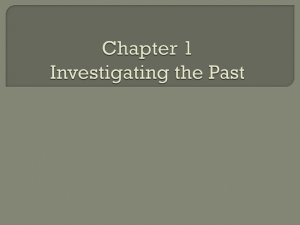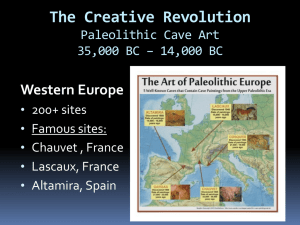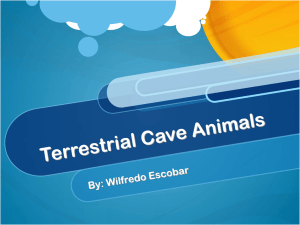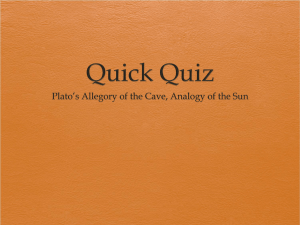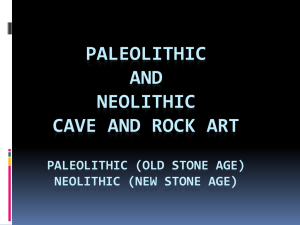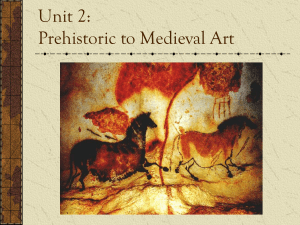notes for part 1
advertisement
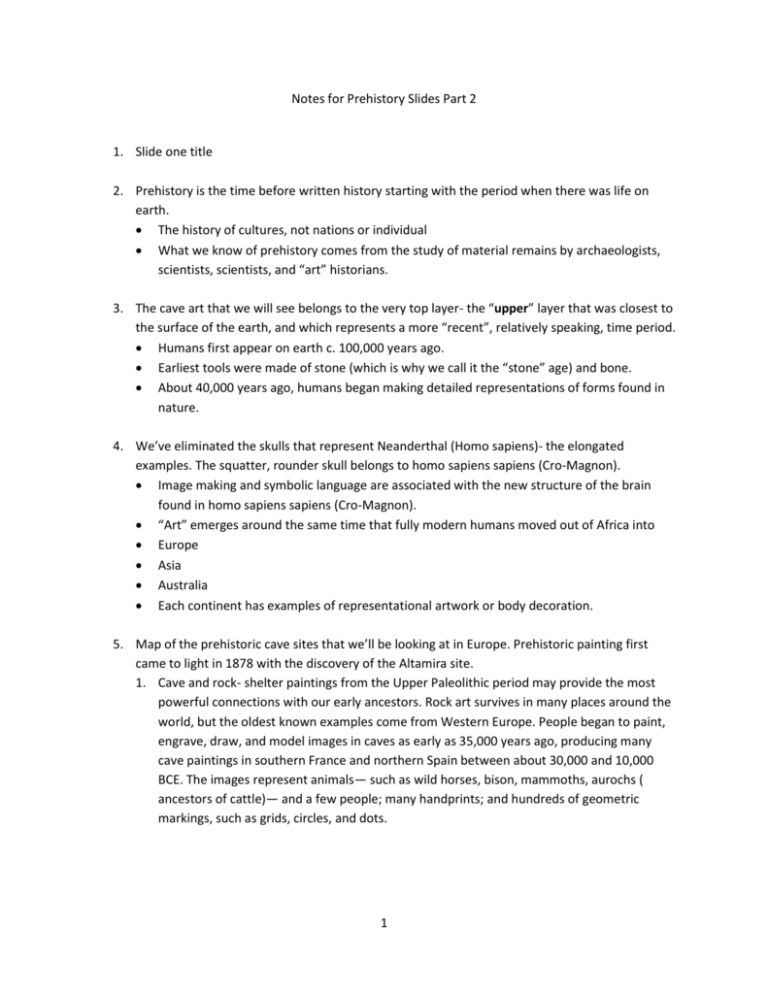
Notes for Prehistory Slides Part 2 1. Slide one title 2. Prehistory is the time before written history starting with the period when there was life on earth. The history of cultures, not nations or individual What we know of prehistory comes from the study of material remains by archaeologists, scientists, scientists, and “art” historians. 3. The cave art that we will see belongs to the very top layer- the “upper” layer that was closest to the surface of the earth, and which represents a more “recent”, relatively speaking, time period. Humans first appear on earth c. 100,000 years ago. Earliest tools were made of stone (which is why we call it the “stone” age) and bone. About 40,000 years ago, humans began making detailed representations of forms found in nature. 4. We’ve eliminated the skulls that represent Neanderthal (Homo sapiens)- the elongated examples. The squatter, rounder skull belongs to homo sapiens sapiens (Cro-Magnon). Image making and symbolic language are associated with the new structure of the brain found in homo sapiens sapiens (Cro-Magnon). “Art” emerges around the same time that fully modern humans moved out of Africa into Europe Asia Australia Each continent has examples of representational artwork or body decoration. 5. Map of the prehistoric cave sites that we’ll be looking at in Europe. Prehistoric painting first came to light in 1878 with the discovery of the Altamira site. 1. Cave and rock- shelter paintings from the Upper Paleolithic period may provide the most powerful connections with our early ancestors. Rock art survives in many places around the world, but the oldest known examples come from Western Europe. People began to paint, engrave, draw, and model images in caves as early as 35,000 years ago, producing many cave paintings in southern France and northern Spain between about 30,000 and 10,000 BCE. The images represent animals— such as wild horses, bison, mammoths, aurochs ( ancestors of cattle)— and a few people; many handprints; and hundreds of geometric markings, such as grids, circles, and dots. 1 6. The images in the Chauvet cave represent 427 different animals and 17 species. Chauvet was discovered in 1994 by three speleologists (people who study caves) or spelunkers (people who explore caves) and was named for one of them: Jean-Marie Chauvet. Chauvet cave contains what so far are the oldest examples of cave painting. 7. Title: Wall Painting with Horses, Rhinoceroses, and Aurochs Medium: Paint on limestone Date: c. 30,000–28,000 BCE Source/Museum: Chauvet Cave, Vallon-Pont-d’Arc, Ardèche Gorge, France NOTE: This is a KEY IMAGE Black and red outline Some images are polychromatic Naturalistic style: Line Shading Modeling Overlapping 8. Horses Facing Each Other : Horse Panel detail of horse head shows use of shading Reindeer: double line on back gives perspective Rhinoceros: horn follows curve of the wall Dated 32,410 +/-720 before the present Originally, before scientific methods were used, paintings were “dated” by how “naturalistic” they appeared. The images in Chauvet were, at first, thought to be much more recent because they conformed to more “modern” tastes in naturalism. Ironically, Chauvet is probably the oldest example of known cave painting, so the presence of “naturalism” cannot be used to determine chronology. 9. Chauvet Cave: an owl. It is said that this is the only depiction of this animal in Paleolithic art. 10. Title slide Pech-Merl cave 11. KEY IMAGE! Spotted Horses and Human Hands Pech-Merle Cave Dordogne, France. Horses: 25,000-24,000 BCE; Hands c. 15,000 BCE Paint of limestone; individual horses are over 5’ (1.5cm) in length (fig. 1-8). 2 Smooth finely detailed heads. Heavy bodies. Massive extended necks. Leg tapering to the hooves. Overlayed with dots. Notice that the horses and the hands were painter c. 10,000 years apart. This demonstrates that the caves were in use for a very long time and that humans returned to the same caves to paint images on the walls. Theories concerning shamanism— a belief in a parallel spirit world accessed through alternative states of consciousness— build upon the earlier ethnographic interpretations, arguing that an animal’s “ spirit” was evident where a bulge in the wall or ceiling suggested its shape, as with the Spotted Horses at Pech- Merle in southwestern France. The artist’s or shaman’s power brought that spirit to the surface. Some scholars have cast the paintings in a central role in early religion, as images for worship. 12. Hands c. 15,000 BCE Human hands occasionally feature on the cave walls, stamped in paint or, more usually, in negative silhouette. “Aerosol” technique- mixing pigment and saliva and spitting the paint like a spray can. This is one theory advanced to explain the negative images (paint applied around the shape of the hand)of the hands. 13. Title slide Lascaux 14. Lascaux: Visit in 1940, Lit by acetylene lamps: Count Begouen and Abbe Henri Breuil in center. Get a sense of the size of the passageways. 15. KEY IMAGE Title: Hall of Bulls Medium: Paint on limestone Size: length of the largest auroch (bull) 18' (5.50 m) Date: c. 15,000 BCE Source/Museum: Lascaux Cave, Dordogne, France The best- known cave paintings today are those at Lascaux, in southern France, where paintings of cows, bulls, horses, and deer date from about 15,000 BCE. The animals appear singly, in rows, face- to- face, tail- to- tail, and even painted on top of one another. Perhaps to ensure a complete image, the horns, eyes, and hooves are shown as seen from the front, while heads and bodies are rendered in profile. The use of twisted perspective is evident in some of these drawings. In twisted perspective, the most characteristic feature of the subject is emphasized. Lascaux was discovered in 1940, but closed to the public in 1963 after visitors’ breath was found to be affecting the paintings. A mock-up, Lascaux II, attracts 250,000 people a year. 3 16. Title: Lascaux: Hall of Bulls (right wall) Date: c. 15,000-13,000 BCE Material: paint on limestone Measurements: length of largest bull 18’ (5.50 m). Location: Lascaux Cave (France) Description: Dordogne, France 17. Title: Bird-Headed Man with Bison Medium: Paint on limestone Size: length approx. 9' (2.75 m) Date: c. 15,000 BCE Source/Museum: Shaft scene in Lascaux Cave One scene at Lascaux is unusual not only because it includes a human figure but also because it is a rare example of a painting that seems to tell a story. But what is this scene telling us? Why did the artist portray the man as only a stick- like figure with a bird’s head when the bison was rendered with such accurate detail? It may be that the painting illustrates a myth regarding the death of a hero. Perhaps it illustrates an actual event. A compelling theory is that it depicts the vision of a shaman. As we know shamanism from practitioners today, shamans were thought to have special powers, an ability to foretell events and assist their people through contact with spirits in the form of animals or birds. Shamans typically make use of trance states, in which they believe they fly and receive communications from their spirit guides. The images they use to record their visions tend to be highly imaginative incorporating geometric figures and combinations of human and animal forms. 18. Note that the human stick figure, which has the head of a bird) and the spear-throwing implement- the stick with the head of a bird (it’s called an atlatl) both evoke bird imagery. 19. The cave paintings at Altamira, in northern Spain , were the first to be discovered, but scholars are still uncovering new information about them. As recently as 2008, specialists used an innovative scientific technique called uranium series dating to discover that prehistoric artists worked here over a very broad time span. The earliest paintings are now placed between 35,000 and 25,000 BCE, and the most recent date from 11,000 BCE. To produce the herd of bison on the ceiling of the main cavern, they used rich red and brown ochers to paint the large areas of the animals’ shoulders, backs, and flanks, then sharp-ened the contours and added the details of the legs, tails, heads, and horns in black and brown, mixing yellow and brown from ochers with iron to make the red tones and deriving black from manganese or charcoal. 4 20. Title: Bison Medium: Paint on limestone Size: length approx. 8'3" (2.5 m) Date: c. 12,500 BCE Source/Museum: Ceiling of a cave at Altamira, Spain In this cave artists capitalized on natural sculptural effects by painting the bodies of their animals over and around geological protuberances in the cave’s walls and ceilings. To produce the herd of bison on the ceiling of the main cavern, they used rich red and brown ochers to paint the large areas of the animals’ shoulders, backs, and flanks, then sharp-ened the contours and added the details of the legs, tails, heads, and horns in black and brown, mixing yellow and brown from ochers with iron to make the red tones and deriving black from manganese or charcoal. 21. Altamira Cave, Northern Spain, Bison priscus or steppe bison (a large-horned species) painted in red and black. C.12,500-12,000 BCE Title Altamira: mask drawn on a rock face in a deep gallery Date ca. 15,000-10,000 B.C Location Spain Measurements: 39.37 in 22. Title: Bison Medium: Unbaked clay Size: length 25" ( 63.5 cm) and 24" (60.9 cm) Date: c. 13,000 BCE Source/Museum: Le Tuc d’Audoubert, France modeling In addition to paintings, caves sometimes had relief sculpture created by modeling, or shaping, the damp clay of the cave’s floor. An excellent example from about 13,000 BCE is preserved at Le Tuc d’Audoubert, south of the Dordogne region of France. Here the sculptor created two bison leaning against a ridge of rock. Although these beasts are modeled in very high relief ( they extend well forward from the background), they display the same conventions employed in paintings, with emphasis on the broad masses of the meatbearing flanks and shoulders. 23. To make the animals even more lifelike, their creator engraved short parallel lines below their necks to represent their shaggy coats. Numerous small footprints found in the clay floor of this cave suggest that important group rites took place here. 5 24. Title: Lamp with ibex design Medium: Engraved stone Size: n/a Date: c. 15,000–13,000 BCE Source/Museum: La Mouthe Cave, Dordogne, France Stone Age peoples appear to have discovered that a wick soaked in and fed by fat or oil would provide a lasting light and, using a hollowed-out stone to hold the light source, created the first lamp. Light came from burning animal fats, since any wood would be damp and incombustible, and would therefore burn too smoky for use in a tent. Lamp technology made it possible to paint deep inside the caves. 25. Map of Neolithic cave shelter sites 26. Neolithic Rock Shelter Art: We’ll look at a few examples from Cogul and El Civil, both on the levantine (east) coast of Spain, one from Algeria in the maghreb (western) region of N. Africa. 27. Title: People and Animals Date: c. 4000–2000 BCE Source/Museum: Detail of rock-shelter painting, Cogul, Lérida, Spain Catalonia Much of what we know of Neolithic daily life comes from material remains of art and architecture. At Cogul, in the province of Lleida in Catalunya, the broad surfaces of a rock shelter were decorated between 4000 and 2000 BCE with elaborate narrative scenes involving dozens of small figures— men, women, children, animals, even insects— seemingly going about daily activities . In the detail shown here, a number of women gracefully stroll or stand about; some in pairs hold hands. The women’s small waists are emphasized by skirts with scalloped hemlines revealing large calves and sturdy ankles, and all the women appear to have shoulder-length hair. The women stand near several large animals, some of which are shown leaping forward with legs fully extended In the flying gallop pose used to portray an animal in motion. What looks different from the paleolithic images that we just saw? These figures are extremely reductive- almost stick figures, although there are details that allow us to make you female and child forms. Line is much more important than modeling- it seems more important to record the event than to spend time on the process of recording the image. 6 28. El Civil site. Levantine Spain- Eastern Mediterranean coast Another example of the simplified “geometric” human form that appears in rock shelter art during this period. 29. Map. Algeria 30. Another example of Neolithic rock shelter found in Algeria One of the most famous North African sites of rock painting. Similar interest in representing human interactions- with other humans (women and children). More schematic than naturalistic. 31. Title slide. 7

